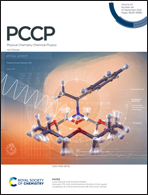Catalyzed reaction of isocyanates (RNCO) with water†
Abstract
The reactions between substituted isocyanates (RNCO) and other small molecules (e.g. water, alcohols, and amines) are of significant industrial importance, particularly for the development of novel polyurethanes and other useful polymers. We present very high-level ab initio computations on the HNCO + H2O reaction, with results targeting the CCSDT(Q)/CBS//CCSD(T)/cc-pVQZ level of theory. Our results affirm that hydrolysis can occur across both the N![[double bond, length as m-dash]](https://www.rsc.org/images/entities/char_e001.gif) C and C
C and C![[double bond, length as m-dash]](https://www.rsc.org/images/entities/char_e001.gif) O bonds of HNCO via concerted mechanisms to form carbamate or imidic acid with ΔH0K barrier heights of 38.5 and 47.5 kcal mol−1. A total of 24 substituted RNCO + H2O reactions were studied. Geometries obtained with a composite method and refined with CCSD(T)/CBS single point energies determine that substituted RNCO species have a significant influence on these barrier heights, with an extreme case like fluorine lowering both barriers by close to 15 kcal mol−1 and most common alkyl substituents lowering both by approximately 3 kcal mol−1. Natural Bond Orbital (NBO) analysis provides evidence that the predicted barrier heights are strongly associated with the occupation of the in-plane C–O* orbital of the RNCO reactant. Key autocatalytic mechanisms are considered in the presence of excess water and RNCO species. Additional waters (one or two) are predicted to lower both barriers significantly at the CCSD(T)/aug-cc-pV(T+d)Z level of theory with strongly electron withdrawing RNCO substituents also increasing these effects, similar to the uncatalyzed case. The 298 K Gibbs energies are only marginally lowered by a second catalyst water molecule, indicating that the decreasing ΔH0K barriers are offset by loss of translational entropy with more than one catalyst water. Two-step 2RNCO + H2O mechanisms are characterized for the formation of carbamate and imidic acid. The second step of these two pathways exhibits the largest barrier and presents no clear pattern with respect to substituent choice. Our results indicate that an additional RNCO molecule might catalyze imidic acid formation but have less influence on the efficiency of carbamate formation. We expect that these results lay a firm foundation for the experimental study of substituted isocyanates and their relationship to the energetic pathways of related systems.
O bonds of HNCO via concerted mechanisms to form carbamate or imidic acid with ΔH0K barrier heights of 38.5 and 47.5 kcal mol−1. A total of 24 substituted RNCO + H2O reactions were studied. Geometries obtained with a composite method and refined with CCSD(T)/CBS single point energies determine that substituted RNCO species have a significant influence on these barrier heights, with an extreme case like fluorine lowering both barriers by close to 15 kcal mol−1 and most common alkyl substituents lowering both by approximately 3 kcal mol−1. Natural Bond Orbital (NBO) analysis provides evidence that the predicted barrier heights are strongly associated with the occupation of the in-plane C–O* orbital of the RNCO reactant. Key autocatalytic mechanisms are considered in the presence of excess water and RNCO species. Additional waters (one or two) are predicted to lower both barriers significantly at the CCSD(T)/aug-cc-pV(T+d)Z level of theory with strongly electron withdrawing RNCO substituents also increasing these effects, similar to the uncatalyzed case. The 298 K Gibbs energies are only marginally lowered by a second catalyst water molecule, indicating that the decreasing ΔH0K barriers are offset by loss of translational entropy with more than one catalyst water. Two-step 2RNCO + H2O mechanisms are characterized for the formation of carbamate and imidic acid. The second step of these two pathways exhibits the largest barrier and presents no clear pattern with respect to substituent choice. Our results indicate that an additional RNCO molecule might catalyze imidic acid formation but have less influence on the efficiency of carbamate formation. We expect that these results lay a firm foundation for the experimental study of substituted isocyanates and their relationship to the energetic pathways of related systems.



 Please wait while we load your content...
Please wait while we load your content...
